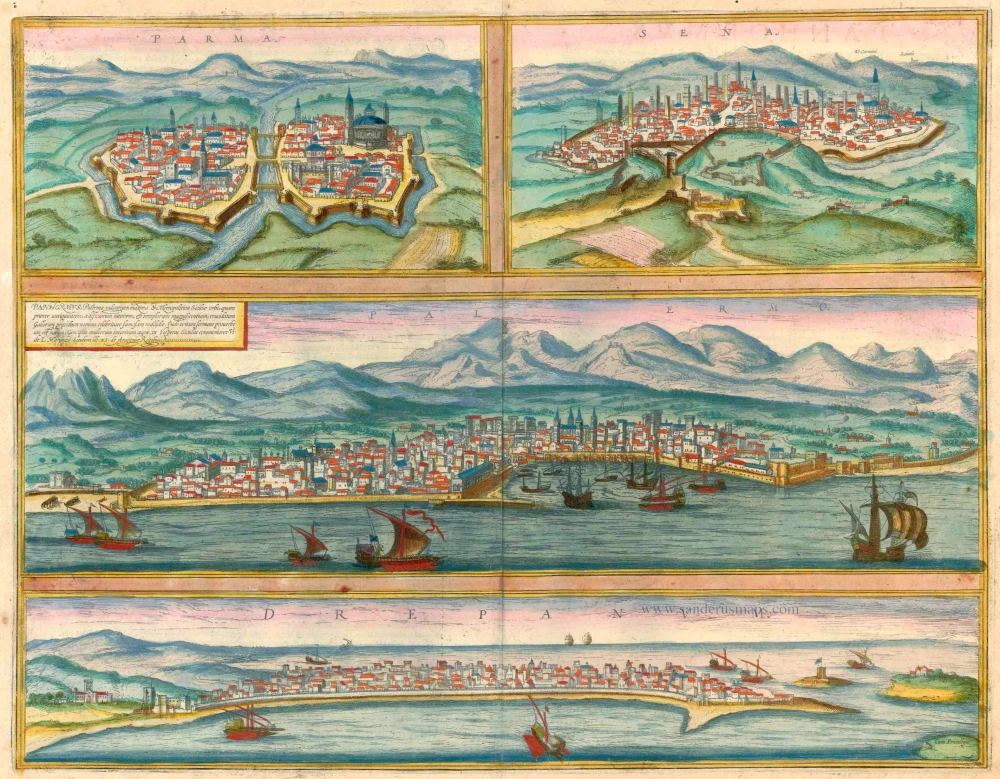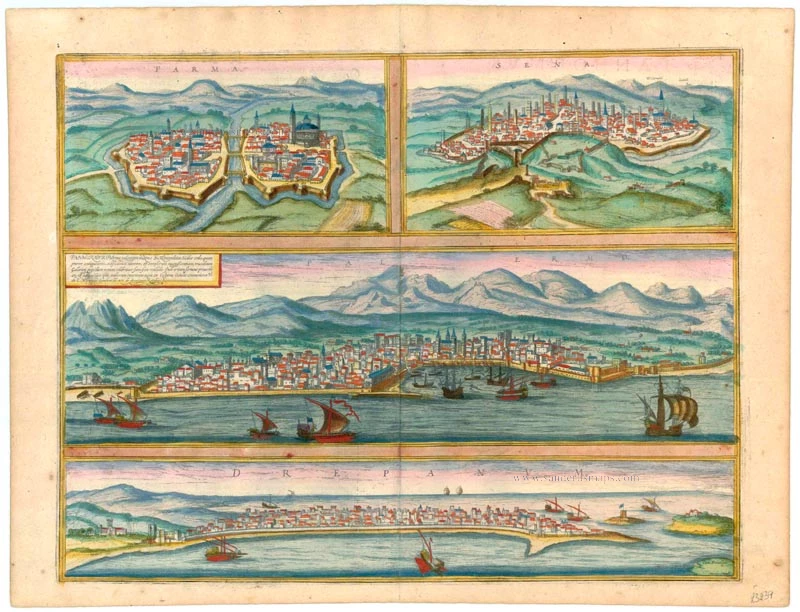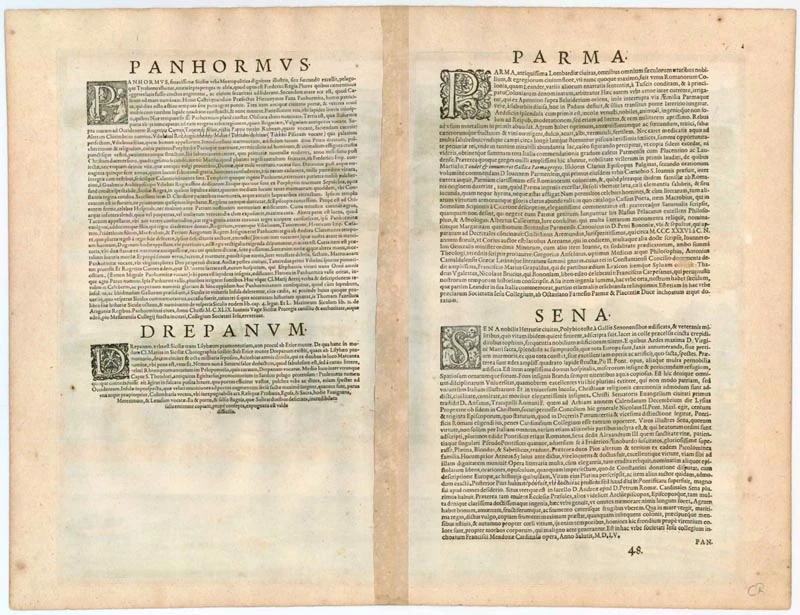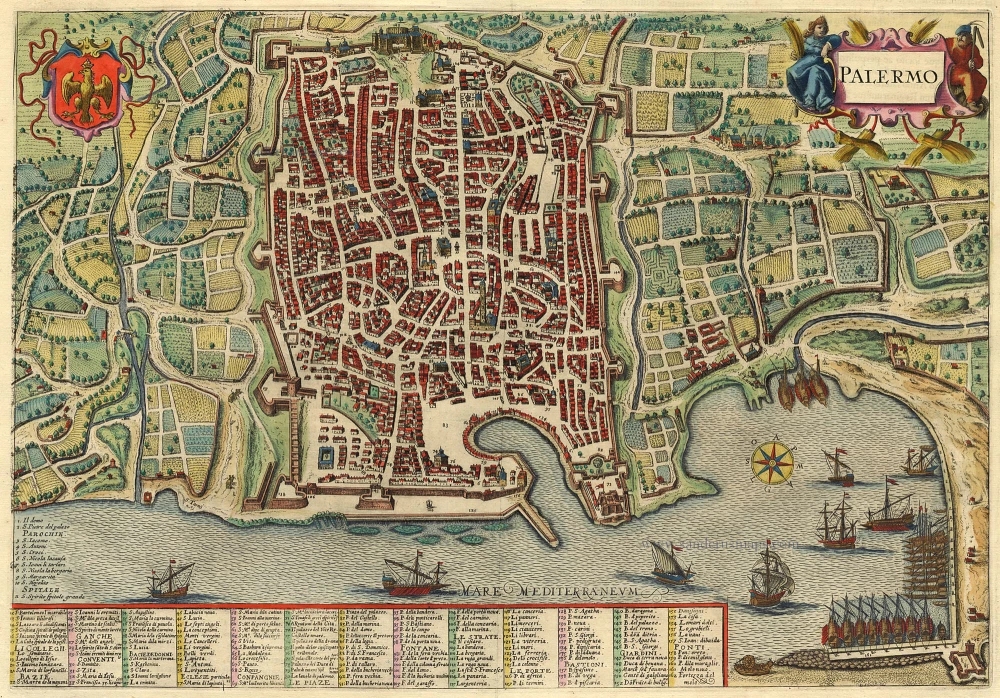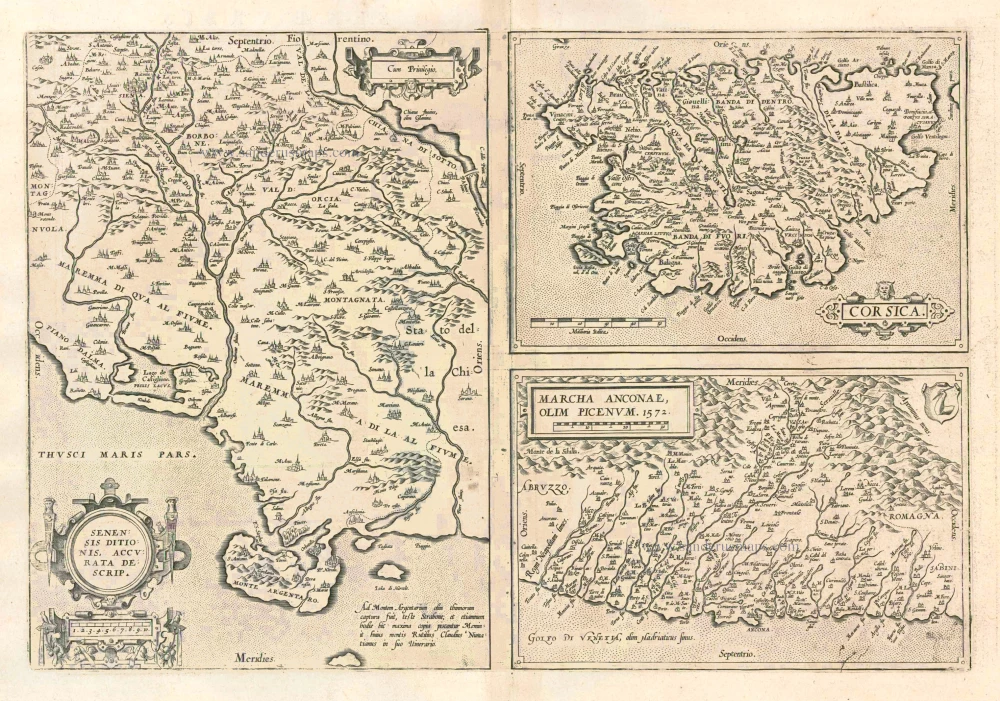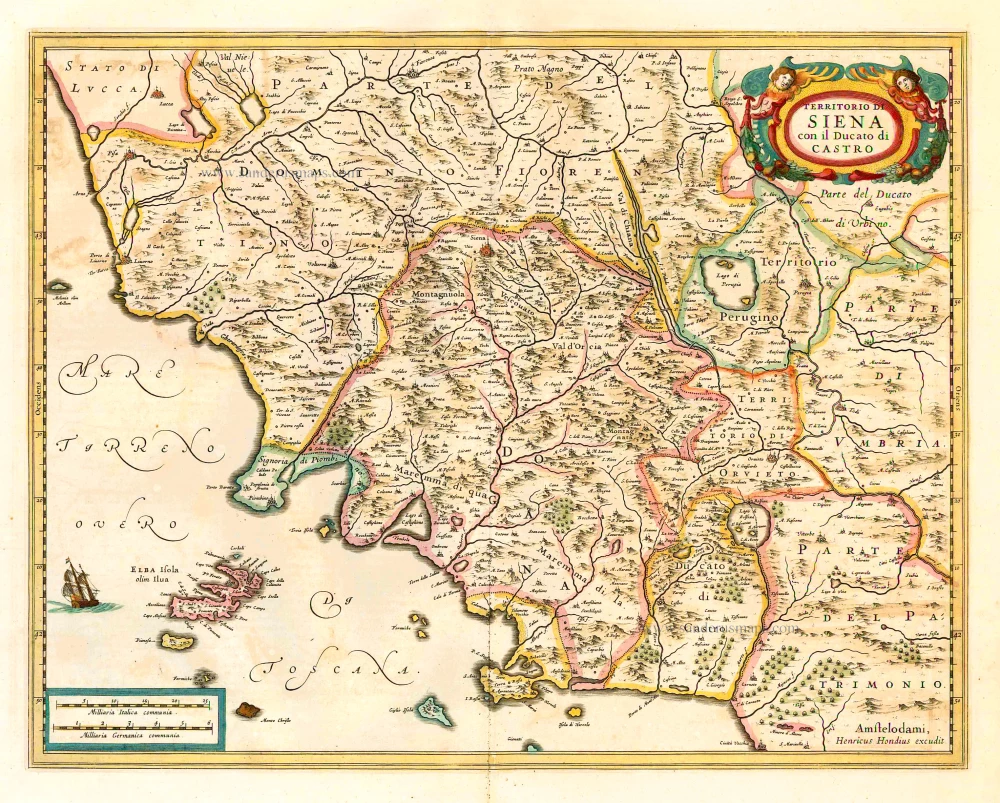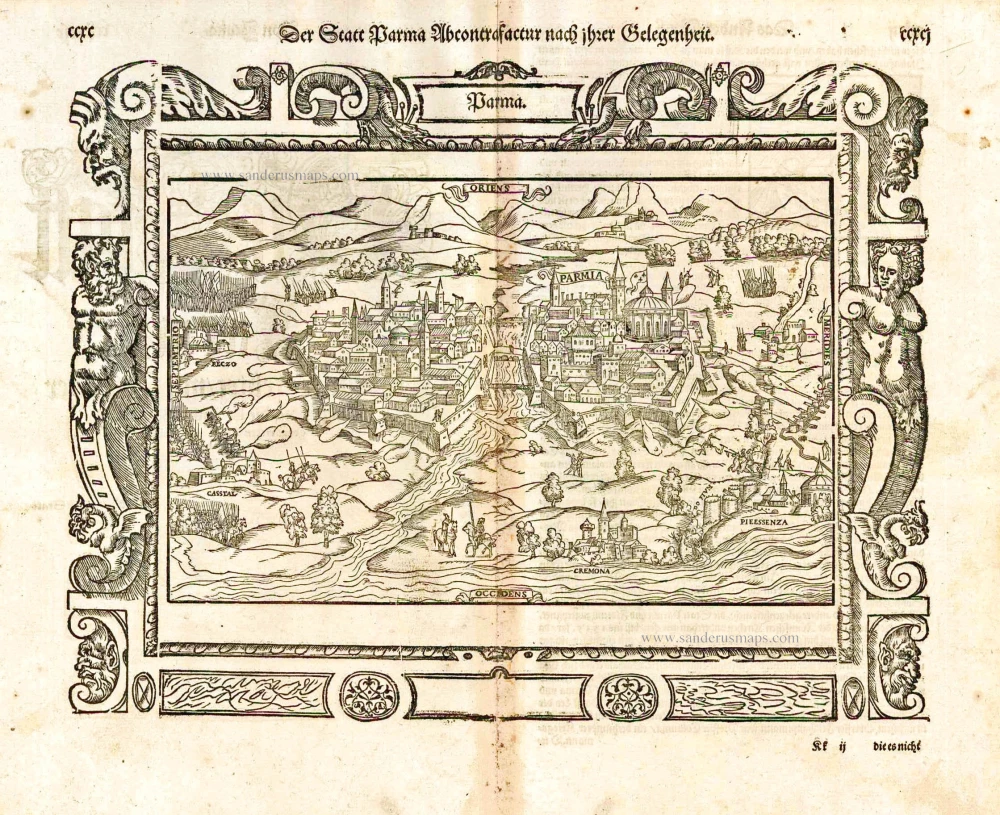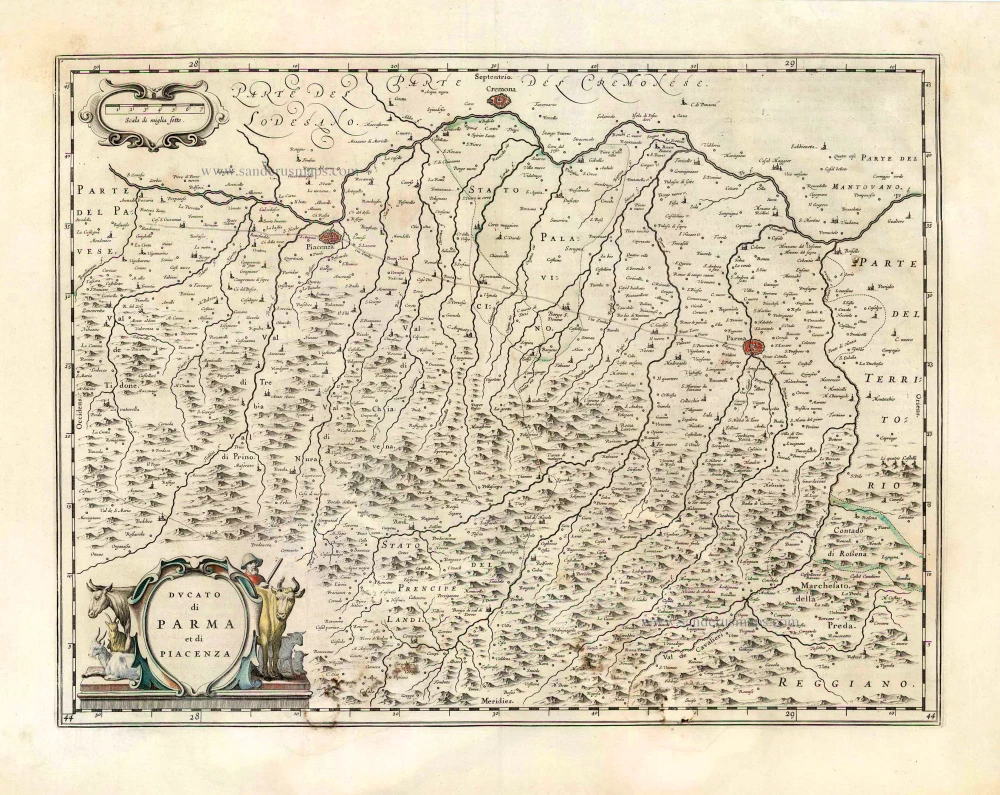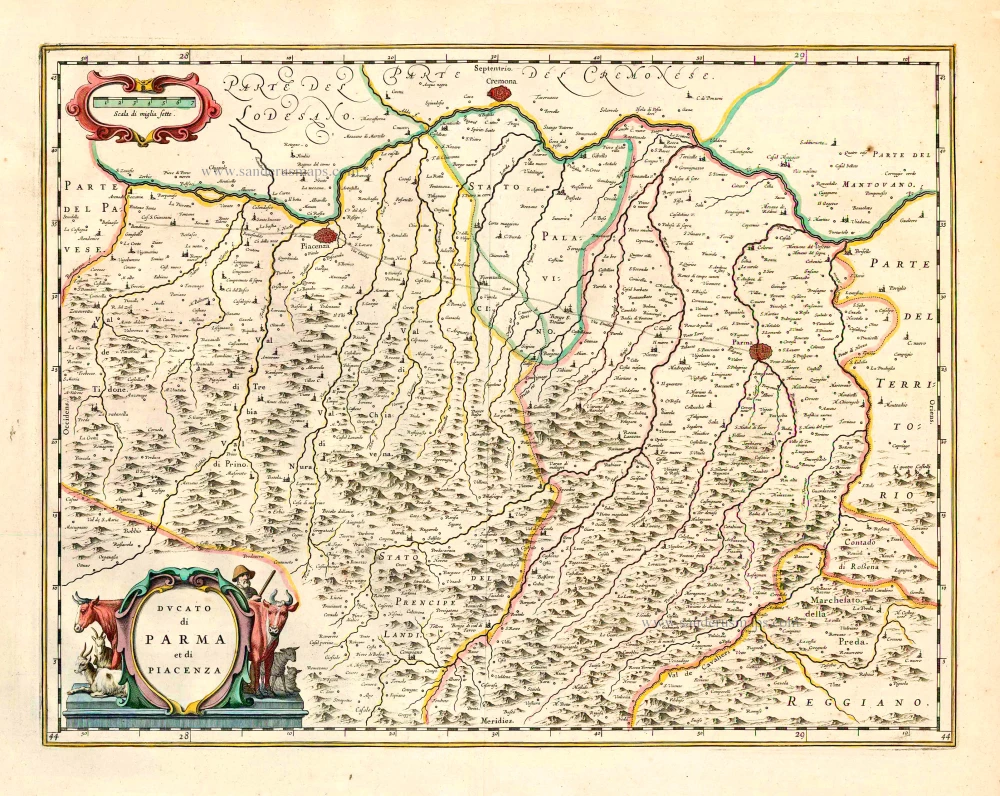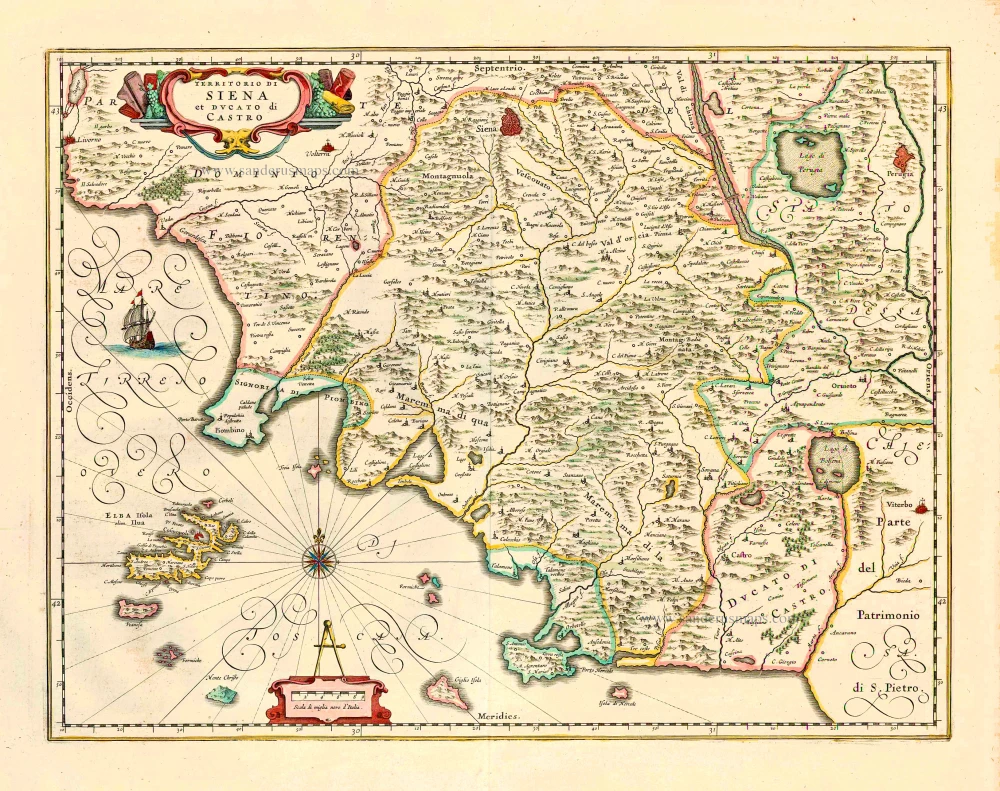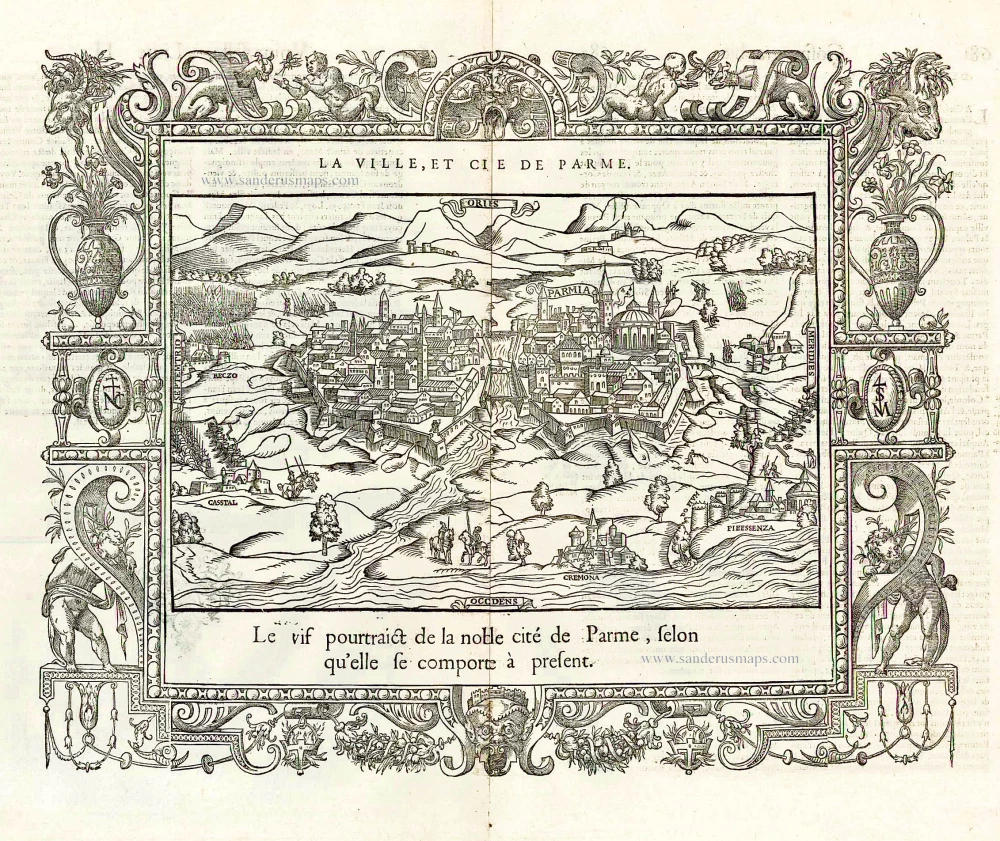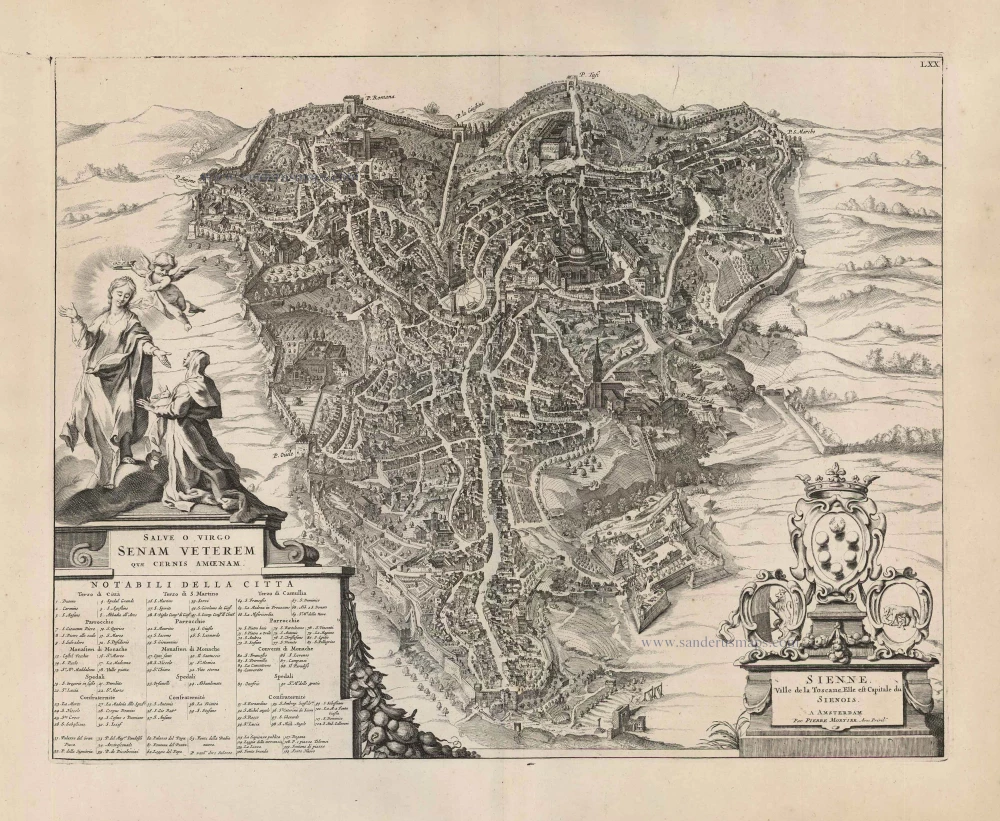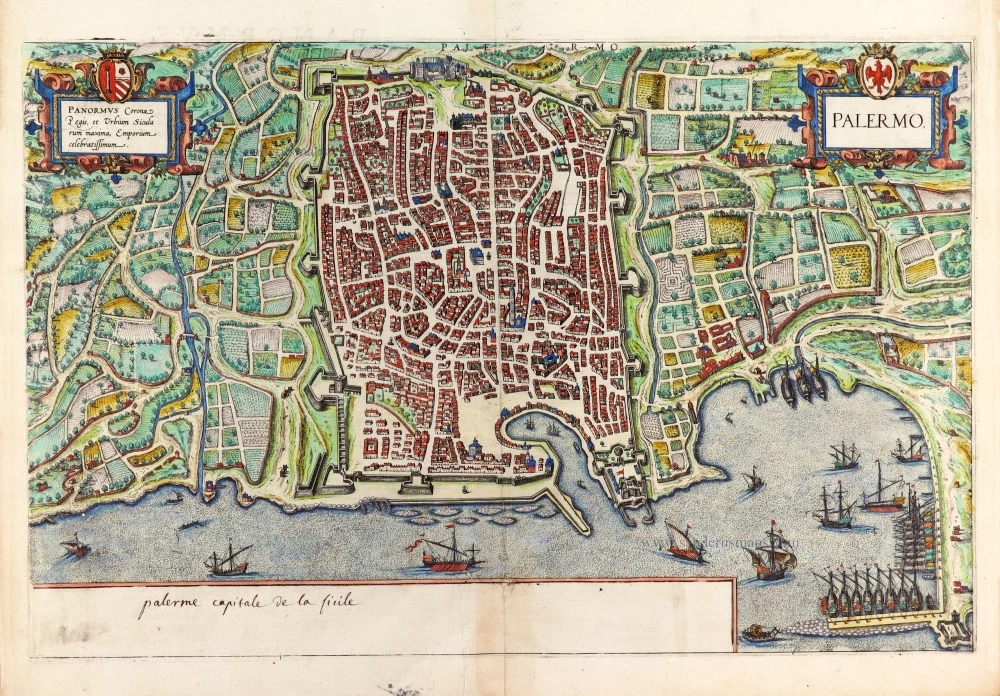Parma - Siena - Palermo - Trapani by Braun & Hogenberg 1612
PARMA
COMMENTARY BY BRAUN: "Parma is an ancient city in Lombardy. The Parma, whose banks are linked by stone bridges, flows between the city and its suburbs. The fields around the city are pleasant and fertile, and they produce wheat, beans and other delicious fruits and various sweet, dry, white and red wines. There are also many spas and lush meadows, and cow pastures. Since they consequently have so much good milk, they supply all of Italy with the cheese made here, called Parmesan."
Parma is shown from an elevated viewpoint. The city is divided in half by the Parma; on the right-hand side, the eye is struck by the imposing domed Romanesque cathedral of the Ascension of the Virgin with the Baptistery behind it. Behind the cathedral's apse stands the San Giovanni Evangelista church, whose cupola is decorated inside with the fresco cycle of the Vision of St John of Patmos by Correggio. In the first half of the 15th century, Parma formed part of the Papal States until the Farnese Pope Paul III created the Duchy of Parma in 1545, after which it was ruled by the Farnese dynasty until 1731. In the right-hand foreground is the Palazzo Ducale, remodelled in 1561 for Ottavio Farnese.
SIENA
COMMENTARY BY BRAUN: "Siena is a noble city that lies on a hill in the region of Etruria in Italy, surrounded by sandstone mountains and embellished with beautiful buildings. Amongst them is a large church to the glory of the Virgin Mary and Mother of Christ: on account of the beautiful marble in which it is clad, and its exquisite and skilful construction, it can be numbered amongst the most beautiful buildings in all of Europe."
Siena is seen from afar, whereby its medieval skyline of family towers gives an immediate impression of the self-confidence of a populace that found itself in artistic and economic competition with Florence and was politically dependent upon Milan or the Emperor. Siena Cathedral (right), with its black and white marble, is an outstanding example of the Gothic style in central Italy. Opposite lies the pilgrims' hospice, Santa Maria della Scala, founded around 1000, containing important 15th-century frescos. The Palazzo Pubblico represents secular power with its all-overshadowing Torre del Mangia. In 1557 Siena became part of the Grand Duchy of Tuscany under Cosimo I de' Medici. The Palio di Siena, a horse race between the city wards, takes place on the Piazza del Campo in July and August.
PALERMO
TRANSLATION OF CARTOUCHE TEXT: Panormus, commonly known as Palermo, largest city and capital of Sicily, whose fame is based not only on its age, the beauty of its buildings and the magnificence of its churches, but also on the slaughter of the French occupying forces. From here comes the well-worn saying: When someone wishes the death of many, he invokes the Sicilian Vespers.
COMMENTARY BY BRAUN: "Palermo is one of the most successful and largest cities in Sicily; it lies in a favourably located attractive valley towards the north, was surrounded by walls by King Henry VI and the Tyrrhenian Sea reaches right up to the city. The Old Town has three gates and old ramparts of massive ashlars, and on one of these towers is written that Palermo is supposed to have been built during the time of Noah."
Rising above the harbour is the massive cathedral of Maria Santissima Assunta, built in the Norman-Arab style in the 12th century and continually expanded from the 14th to the 16th century. The plate records its appearance in the mid-16th century with four corner towers and with Gothic spires. The crypt contains the tombs of the Hohenstaufen emperors Henry VI and Frederick II. Within Sicily's eventful history, the Hohenstaufens were responsible for flowering the arts in Palermo from 1194. The French occupying forces and Sicilian Vespers mentioned in the cartouche refer to the bloody uprising by the Sicilians against the rule of Charles I of Anjou, whom the Pope had appointed King of Sicily in 1266.
TRAPANI
COMMENTARY BY BRAUN: "The town of Drepanum lies beneath Mount Erice; eighteen miles away lie the Lilybaeum Foothills, separated from the city by the River Acinthium. [...] The town lies on a peninsula that curves westward and forms a strong, safe harbour. It is surrounded by numerous large islands, making the harbour bigger."
Trapani, on the west coast of Sicily, is shown from the sea, whereby the curved natural harbour explains the town's name (Gr. Drepanum, "sickle"). A strategic base for the Carthaginians in the First Punic War, in 241 BC, Trapani was conquered by the Romans. With the arrival of the Arabs in the 9th century, the town saw an economic upswing. In 1266 it came under the rule of Charles I of Anjou and then passed to the Kingdom of Aragon. In the 15th century, it became western Sicily's most important port, a position it has retained up to the present. (Taschen)
Parma [on sheet with] Sena [and] Panhormus, Palermo vulgariter, ... [and] Drepanum
Item Number: 23239 Authenticity Guarantee
Category: Antique maps > Europe > Italy - Cities
Four bird's-eye views on one sheet: Parma, Siena, Palermo and Trapani by Georg Braun and Frans Hogenberg.
Title: Parma [on sheet with] Sena [and] Panhormus, Palermo vulgariter, ... [and] Drepanum.
Date of the first edition: 1572.
Date of this map: 1612.
Copper engraving, printed on paper.
Image size: 365 x 468mm (14.37 x 18.43 inches).
Sheet size: 410 x 535mm (16.14 x 21.06 inches).
Verso: Latin text.
Condition: Excellent, superb old colour.
Condition Rating: A+.
From: Civitates Orbis Terrarum, Liber Primus. Cologne, Petrus von Brachel, 1612. (Van der Krogt 4, 41:1.1(1612))
PARMA
COMMENTARY BY BRAUN: "Parma is an ancient city in Lombardy. The Parma, whose banks are linked by stone bridges, flows between the city and its suburbs. The fields around the city are pleasant and fertile, and they produce wheat, beans and other delicious fruits and various sweet, dry, white and red wines. There are also many spas and lush meadows, and cow pastures. Since they consequently have so much good milk, they supply all of Italy with the cheese made here, called Parmesan."
Parma is shown from an elevated viewpoint. The city is divided in half by the Parma; on the right-hand side, the eye is struck by the imposing domed Romanesque cathedral of the Ascension of the Virgin with the Baptistery behind it. Behind the cathedral's apse stands the San Giovanni Evangelista church, whose cupola is decorated inside with the fresco cycle of the Vision of St John of Patmos by Correggio. In the first half of the 15th century, Parma formed part of the Papal States until the Farnese Pope Paul III created the Duchy of Parma in 1545, after which it was ruled by the Farnese dynasty until 1731. In the right-hand foreground is the Palazzo Ducale, remodelled in 1561 for Ottavio Farnese.
SIENA
COMMENTARY BY BRAUN: "Siena is a noble city that lies on a hill in the region of Etruria in Italy, surrounded by sandstone mountains and embellished with beautiful buildings. Amongst them is a large church to the glory of the Virgin Mary and Mother of Christ: on account of the beautiful marble in which it is clad, and its exquisite and skilful construction, it can be numbered amongst the most beautiful buildings in all of Europe."
Siena is seen from afar, whereby its medieval skyline of family towers gives an immediate impression of the self-confidence of a populace that found itself in artistic and economic competition with Florence and was politically dependent upon Milan or the Emperor. Siena Cathedral (right), with its black and white marble, is an outstanding example of the Gothic style in central Italy. Opposite lies the pilgrims' hospice, Santa Maria della Scala, founded around 1000, containing important 15th-century frescos. The Palazzo Pubblico represents secular power with its all-overshadowing Torre del Mangia. In 1557 Siena became part of the Grand Duchy of Tuscany under Cosimo I de' Medici. The Palio di Siena, a horse race between the city wards, takes place on the Piazza del Campo in July and August.
PALERMO
TRANSLATION OF CARTOUCHE TEXT: Panormus, commonly known as Palermo, largest city and capital of Sicily, whose fame is based not only on its age, the beauty of its buildings and the magnificence of its churches, but also on the slaughter of the French occupying forces. From here comes the well-worn saying: When someone wishes the death of many, he invokes the Sicilian Vespers.
COMMENTARY BY BRAUN: "Palermo is one of the most successful and largest cities in Sicily; it lies in a favourably located attractive valley towards the north, was surrounded by walls by King Henry VI and the Tyrrhenian Sea reaches right up to the city. The Old Town has three gates and old ramparts of massive ashlars, and on one of these towers is written that Palermo is supposed to have been built during the time of Noah."
Rising above the harbour is the massive cathedral of Maria Santissima Assunta, built in the Norman-Arab style in the 12th century and continually expanded from the 14th to the 16th century. The plate records its appearance in the mid-16th century with four corner towers and with Gothic spires. The crypt contains the tombs of the Hohenstaufen emperors Henry VI and Frederick II. Within Sicily's eventful history, the Hohenstaufens were responsible for flowering the arts in Palermo from 1194. The French occupying forces and Sicilian Vespers mentioned in the cartouche refer to the bloody uprising by the Sicilians against the rule of Charles I of Anjou, whom the Pope had appointed King of Sicily in 1266.
TRAPANI
COMMENTARY BY BRAUN: "The town of Drepanum lies beneath Mount Erice; eighteen miles away lie the Lilybaeum Foothills, separated from the city by the River Acinthium. [...] The town lies on a peninsula that curves westward and forms a strong, safe harbour. It is surrounded by numerous large islands, making the harbour bigger."
Trapani, on the west coast of Sicily, is shown from the sea, whereby the curved natural harbour explains the town's name (Gr. Drepanum, "sickle"). A strategic base for the Carthaginians in the First Punic War, in 241 BC, Trapani was conquered by the Romans. With the arrival of the Arabs in the 9th century, the town saw an economic upswing. In 1266 it came under the rule of Charles I of Anjou and then passed to the Kingdom of Aragon. In the 15th century, it became western Sicily's most important port, a position it has retained up to the present. (Taschen)

